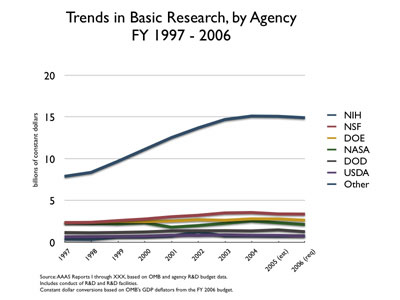Industry Continues to Push for Basic Research, White House Growing Defensive
Interesting article (sub. req’d) in Tech Daily today about an event hosted by the Semiconductor Industry Association which brought together Intel CEO Craig Barrett, Micron Technology CEO Steve Appleton, and Harvard Economist Dale Jorgenson to talk about the importance of federal support for fundamental research and math and science education. They sounded a theme that’s been heard increasingly from industry groups and policymakers in the last few weeks: “American technology leadership is under an assault that can only be countered through improved basic research investment and better science education in American schools.”
“Congress shouldn’t play Sputnik with this; we have to plan in advance,” Intel CEO Craig Barrett said at a press conference convened by the Semiconductor Industry Association (SIA). Sputnik was the Russian rocket launched in 1957 that began the “space race” with the United States.
…
For the semiconductor industry, the problem is physics. Current technology uses complementary metal-oxide semiconductors (CMOS) — the ubiquitous silicon chip. But in the race to cram more tiny transistors onto chips, the industry will exhaust the parameters of CMOS and need to make a major technical jump into nanotechnology, which focuses on matter at the atomic level.
“U.S. leadership in nanoelectronics is not guaranteed,” Barrett said. “It will take a massive, coordinated U.S. research effort involving academia, industry, and state and federal governments to ensure that America continues to be the world leader in information technology.”
The press conference once again put the Administration on the defensive for a budget request that cuts basic research in the physical sciences by $39 million in FY 2006. White House Office of Science and Technology Policy Director John Marburger repeated what he told a House Appropriations Committee earlier this week, when he said he didn’t believe that U.S. competitiveness was at risk:
Presidential science adviser John Marburger said he hears the warnings but feels that U.S. competitiveness is not facing an immediate crisis. “It’s kind of hard to see into the future,” he said. “The U.S. is so far ahead in these areas that we are going to be able to maintain our competitive strength. I don’t see the same danger signs.”
…And then argued that R&D advocates shouldn’t focus on what the President is proposing this year, they should look at the growth over the last 5 years:
Many high-tech advocacy groups are relying on R&D budget figures that misrepresent the level of true federal investment, Marburger said. Taken in five-year increments, overall basic research spending between fiscal 2002 and fiscal 2006 is up $28 billion over the same period starting in 1997, in constant dollars, according to data from the White House Office of Science and Technology. But for fiscal 2006, the administration has requested cutting spending on basic physical sciences by $39 million, to $2.8 billion.
R&D spending advocates, including the Alliance for Technology Research in America, SIA and TechNet, point to a 25-year flat line on funding for basic research on physical sciences and engineering at $8 billion per year as proof of the problem.
Marburger said they are slicing data to support their case. “We are by far the major investor in basic research in most fields,” he said.
Honestly, Marburger is doing just what he accuses ASTRA of doing. While it’s true that basic research is up in aggregate over the time-period he suggests, almost all of that increase is the result of the doubling of NIH. Every other agency, including those agencies responsible for supporting basic research in the physical sciences, is essentially flat over the period.

(click to enlarge)
Of course, this is exactly the point SIA and ASTRA were trying to make…in addition to the Task Force on the Future of American Innovation, Council on Competitiveness, the American Electronics Association, CSPP, TechNet and all the others who have argued in recent weeks that our failure to adequately support fundamental research in the physical sciences reduces our future innovative capacity and ultimately our future competitiveness.








